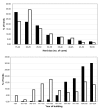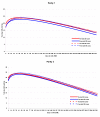Housing system and herd size interactions in Norwegian dairy herds; associations with performance and disease incidence
- PMID: 20158884
- PMCID: PMC2833153
- DOI: 10.1186/1751-0147-52-14
Housing system and herd size interactions in Norwegian dairy herds; associations with performance and disease incidence
Abstract
Background: According to the Norwegian animal welfare regulations, it has been forbidden to build new tie-stall barns since the end of 2004. Previous studies have shown that cow performance and health differ between housing systems. The interaction between housing system and herd size with respect to performance and disease incidence has not been evaluated.
Methods: Cow performance and health in 620 herds housed in free-stall barns were compared with in 192 herds housed in tie-stall barns based on a mail survey and data from the Norwegian Dairy Herd Recording and Cattle Health Systems. The housing systems herds were comparable with respect to herd size (15-55 cows). Associations between performance/disease incidence and housing system, herd size and year of building the cow barn were tested in general linear models, and values for fixed herd size of 20 and 50 cows were calculated. On the individual cow level mixed models were run to test the effect of among others housing system and herd size on test-day milk yield, and to evaluate lactation curves in different parities. All cows were of the Norwegian Red Breed.
Results: Average milk production per cow-year was 134 kg lower in free-stall herd than in tie-stall herds, but in the range 27-45 cows there was no significant difference in yields between the herd categories. In herds with less than 27 cows there were increasingly lower yields in free-stalls, particularly in first parity, whereas the yields were increasingly higher in free-stalls with more than 45 cows.In free-stalls fertility was better, calving interval shorter, and the incidence rate of teat injuries, ketosis, indigestions, anoestrus and cystic ovaries was lower than in tie-stalls. All of these factors were more favourable in estimated 50-cow herds as compared to 20-cow herds. In the larger herd category, bulk milk somatic cell counts were higher, and the incidence rate of mastitis (all cases) and all diseases was lower.
Conclusion: This study has shown that there is an interaction between housing system and herd size, and that performance and health is not universally better in small free-stalls than in tie-stalls.
Figures





Similar articles
-
Udder health of cows changing from tie stalls or free stalls with conventional milking to free stalls with either conventional or automatic milking.J Dairy Sci. 2009 Aug;92(8):3696-703. doi: 10.3168/jds.2008-1962. J Dairy Sci. 2009. PMID: 19620651
-
Comparison of ketosis, clinical mastitis, somatic cell count, and reproductive performance between free stall and tie stall barns in Norwegian dairy herds with automatic feeding.Acta Vet Scand. 1997;38(2):181-92. doi: 10.1186/BF03548498. Acta Vet Scand. 1997. PMID: 9257454 Free PMC article.
-
Herd-level risk factors for cow and calf on-farm mortality in Estonian dairy herds.Acta Vet Scand. 2020 Mar 12;62(1):15. doi: 10.1186/s13028-020-0513-x. Acta Vet Scand. 2020. PMID: 32164740 Free PMC article.
-
A systematic review and meta-analyses of risk factors associated with lameness in dairy cows.BMC Vet Res. 2019 Oct 16;15(1):346. doi: 10.1186/s12917-019-2095-2. BMC Vet Res. 2019. PMID: 31619239 Free PMC article.
-
Extended lactations in dairy cows and the effects on fertility and production.Reprod Domest Anim. 2024 Sep;59 Suppl 2:e14690. doi: 10.1111/rda.14690. Reprod Domest Anim. 2024. PMID: 39233584 Review.
Cited by
-
Epidemiological Features of Postpartum Subclinical Ketosis in Dairy Herds in Hokkaido, Japan.Animals (Basel). 2023 Dec 31;14(1):144. doi: 10.3390/ani14010144. Animals (Basel). 2023. PMID: 38200875 Free PMC article.
-
Effects of feeding management on disease incidence and blood metabolites in dairy herds in Iwate Prefecture, Japan.J Vet Med Sci. 2019 Jul 11;81(7):958-967. doi: 10.1292/jvms.18-0742. Epub 2019 May 28. J Vet Med Sci. 2019. PMID: 31142681 Free PMC article.
-
Comparison of Cattle Housing Systems Based on the Criterion of Damage to Barn Equipment and Construction Errors.Animals (Basel). 2022 Sep 22;12(19):2530. doi: 10.3390/ani12192530. Animals (Basel). 2022. PMID: 36230271 Free PMC article.
-
Risk factors associated with cystic ovarian disease in Norwegian dairy cattle.Acta Vet Scand. 2010 Nov 8;52(1):60. doi: 10.1186/1751-0147-52-60. Acta Vet Scand. 2010. PMID: 21059258 Free PMC article.
-
Welfare of dairy cows.EFSA J. 2023 May 16;21(5):e07993. doi: 10.2903/j.efsa.2023.7993. eCollection 2023 May. EFSA J. 2023. PMID: 37200854 Free PMC article.
References
-
- Scientific Option of the Panel on Animal Health and welfare on request from European Commission on welfare of dairy cows. The EFSA Journ. 2009;1143:1–38.
-
- Bakken G, Røn I, Østerås O. Clinical disease in dairy cows in relation to housing systems. Proceedings VIth Int Congress on Animal Hygiene: 14-17 June 1988; Skara. 1988. pp. 18–22.
-
- Østerås O. Sykdomsforekomst hos kyr i båsfjøs og løsdriftsfjøs (Disease incidence in cows in tie-stalls and free-stalls) Husdyrforsøksmøtet 1990; Ås. Aktuelt fra Statens fagtjeneste for landbruket nr. 4. 1990. pp. 232–237.
Publication types
MeSH terms
LinkOut - more resources
Full Text Sources
Miscellaneous

